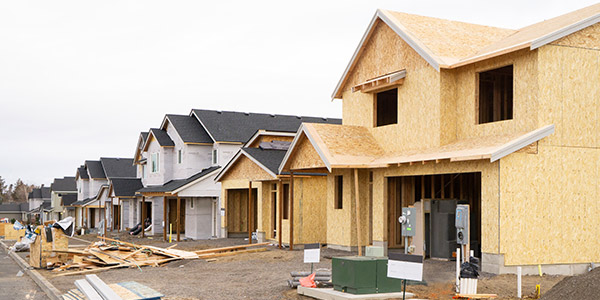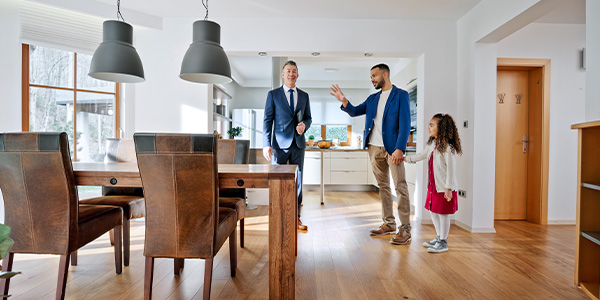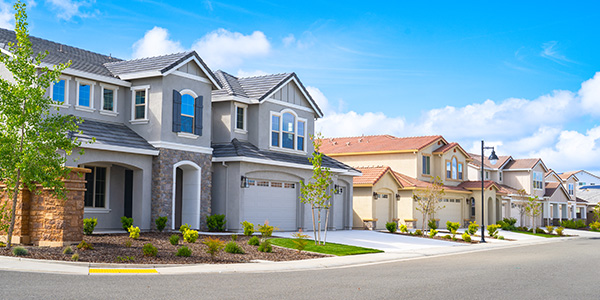Homebuyers
How Much Does It Cost to Build a House?
May 2, 2024
Could a new build be the best way for you to start your journey to homeownership? This can be an exciting way to get a home with all of the specifications you want in the area where you want to live. However, building a home can also be one of the most challenging tasks a person ever takes on. How much does it cost to build a home? This overview of how to build a home can help you decide if this path is right for you.
Understanding the Costs of Building a House
The cost to build a new home is generally estimated by square feet. To estimate the cost of building your new home, multiply its anticipated square footage by the average cost per square foot. Low-end to average new constructions will generally cost from $140 to $250 per square foot. High-end builds can cost between $250 and $800 per square foot. Of course, these are merely rough estimates that can vary widely based on the specifics of your home.
Key Factors Affecting Construction Costs
Costs to build the same home in two different locations can vary widely. Here's a look at the top factors influencing the cost of building a new home:
- Land Costs: The cost of your lot will be one of the biggest factors impacting the price. Both the size and desirability of the lot affect its value.
- Size and Layout: While larger square footage requires more materials, tools, time, and labor, the layout can also influence price because custom or complicated layouts also require additional resources. Extra bedrooms and bathrooms can significantly increase construction costs.
- Materials: Selecting premium materials for a home's interior and exterior can dramatically increase construction costs. For example, architectural shingles, metal roofs, wood flooring, and natural stone can all increase pricing compared to contractor-grade materials.
- Labor: Labor costs can vary by region and state based on economic factors, demand, and local wages.
- Permits and Regulations: In areas with strict permit requirements, both time and money can go into obtaining permits and undergoing inspections at various points in the construction process. Contractors generally account for these costs when billing by square foot.
Breakdown of Average Homebuilding Costs
Did you know that many of the most expensive building costs happen long before you ever break ground on a home? Here's a look at common costs at different stages of a new build:
- Pre-Construction Phase: If a lot needs to be cleared of trees or overgrowth, this can require a significant investment. In addition, most lots require some excavation work to build the foundation. Excavation may be more expensive in areas with rocky soil that may contain boulders that need to be removed. In some cases, the person having a home built may also be responsible for paying for a well, installing a septic tank, or trenching a gas line.
- Construction Phase: Once construction is ready to begin, your contractor will begin framing over the foundation. Next comes roofing. Finally, all of the exterior finishes that can include siding, doors, windows, fixtures, and trim will be added.
- Interior Costs: Big projects in a home's interior include drywall, flooring, fireplaces, kitchen cabinets, and bathroom cabinets. This will be the phase where the buyer picks out all of the details that will help to create a home's interior theme.
- Systems Installation: It's common for excited buyers to overlook some of the technical details of a new construction. However, it's important to know that plumbing, electrical, and HVAC (heating, ventilation, and air conditioning) will all need to be installed from scratch.
- Post-Construction Phase: Some final touches that increase curb appeal, accessibility, and connectivity account for final costs in the post-construction phase of a new build.
- Landscaping: The size and topography of a yard or lot will dictate landscaping costs. Costs can include seeding grass, adding turf, adding walkways and paths, planting trees, and adding privacy shrubs.
- Driveway: The cost of a driveway can vary based on length, terrain, and the materials used. Concrete, asphalt, pavers, and stone are all common options. Some driveways also require extra drainage.
- Technology Upgrades and Home Automation: Lighting, security systems, smart features, and other final touches can be added either before or after the new owner moves in.
How to Budget for Building Your Home
In many ways, budgeting for a new build is similar to budgeting to purchase a home that's already on the market. However, pricing can be a little more unpredictable because you need to get quotes from builders instead of simply looking at prices for recent home sales. The process will also vary based on whether you're going through a builder offering lots or hiring a contractor to build on a piece of land you've purchased separately.
Start by deciding the size of the home you want, the layout you like, and the number of bedrooms and bathrooms you'd like. With the average price per square foot in mind in your area, get a rough idea in your mind of the total cost of the home. If you'll be obtaining a new construction loan, you'll need to begin putting money aside for a down payment. This will be a separate payment from the deposit most builders require when selling new constructions. A home affordability calculator can be a good place to start.
It's also wise to consider unexpected costs. Everything from rising costs for raw materials to an unexpected issue that's discovered with your property could increase your final cost to build a home. Consider creating a contingency fund that totals around 5% to 10% of your total budget.
What are some tips for saving money on home construction? While there are no cutting corners when it comes to code and safety requirements, it's often possible to make building a home less expensive through a combination of savvy and sacrifice. Consider these tips:
- Reduce square footage.
- Choose stock designs.
- Choose a one-story ranch, saltbox, or other basic home style.
- Select a simple roofing system.
- Use showers instead of baths in bathrooms.
- Keep the basement unfinished.
- Select a predesigned plan from your builder.
- Stick to your plans! Last-minute change orders can dramatically increase the cost to build.
- Don't be afraid to spend money in the right places. If you don't know how to build a home, hiring a contractor can be a wise investment that can save you from expensive mistakes that can come from trying to be your own general contractor.
Financing Your Home Construction
Construction loans can help to cover the cost of building a new home instead of buying one that's already built. After approval, the lender will typically disburse the money to the borrower in installments to cover the ongoing cost of construction. After completion, the loan can either be paid in full or converted to a permanent mortgage that resembles the type of loan you'd get when buying an existing home on the market. These two loan types are known as construction-only loans (one-time close) and construction-to-permanent (two-time close) loans.
Choosing the right loan option will depend on the cost of the home, your budget and finances, and how quickly you intend to pay off the loan. The best way to find the right loan for financing your new home construction is to speak with a mortgage advisor.
Regional Cost Variations
It should come as no surprise that building costs vary around the country. Generally, building a home in high-cost-of-living areas is higher than building in low-cost-of-living areas. The Southeast United States is one of the least expensive areas to build in. One analysis found that the average cost of building a 2,100-square-foot home in Mississippi, Arkansas, Alabama, Louisiana, North Carolina, and Florida is below average. Hawaii is the most expensive state for building a home. The West Coast and Northeast also have higher building costs.
Cost Comparison: Building vs. Buying a House
Many people are surprised to learn that building sometimes offers superior home affordability compared to buying. According to an analysis from Money.com, these are the 20 states where it's either cheaper or more expensive to build a new home over buying an existing one based on median home prices.
Of course, it's important to compare similarly sized properties when analyzing the cost of building a home versus buying an existing one. Your personal preferences also matter. Let's close with the pros and cons of either buying or building your next home!
Buying Pros and Cons
Pros:
- You can move in right after closing.
- Financing is simpler.
- You can move into an established neighborhood.
- Opportunities exist for buying historic properties.
Cons:
- The home may need renovations.
- You can't choose all of the features you want.
- There may be many bids on a single home.
Building Pros and Cons
Pros:
- You can design a custom home with all the features you need.
- Your home will have the latest codes, materials standards, and efficiency features.
- You can generally put off repairs and updates for many years.
Cons:
- You may need to rent while waiting for the home to be built.
- Pricing may limit you from getting the square footage or features you need.
- While very doable, obtaining financing requires more paperwork.
- Costs can be less predictable.
- Committing to a home in this way can be overwhelming for a first-time homebuyer who isn't sure where they want to plant roots.






 Smart Moves Start Here.
Smart Moves Start Here.